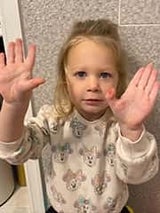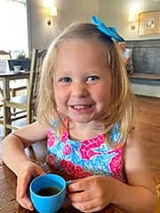Trigger Thumbs: Madelyn’s Story
Trigger Thumbs: Madelyn’s Story
One morning in late January, Steve noticed his 2-year-old daughter’s left thumb seemed stuck in a bent position. He called his wife, Ashley, to look. Both parents encouraged Madelyn to try to straighten her thumb, but the toddler couldn’t. She said her thumb didn’t hurt, it just didn’t “move right” and made it more difficult to pick up her dolls.

A google search of the toddler’s symptoms suggested she may have trigger thumb, a common musculoskeletal disorder that affects about 4 in every 1,000 children. Concerned, Madelyn’s parents called the Orthopedic Center at Children’s Hospital of Philadelphia (CHOP) to schedule an appointment.
Days later, Madelyn and her mom met with Apurva S. Shah, MD, MBA, an orthopedic surgeon with CHOP’s Hand and Arm Disorders Program, at the Buerger Center for Advanced Pediatric Care in Philadelphia.
After examining both of Madelyn’s hands and asking her to perform a few small tasks, Dr. Shah diagnosed the toddler with bilateral trigger thumb. Not only was her left thumb affected – the one stuck in a bent position – but also her right, which was stuck in an extended or more open position, which was less noticeable to her parents.
Treatment for trigger thumb
Trigger thumb is a common childhood condition that occurs when the tendon that moves the thumb enlarges and doesn’t slide smoothly through the tendon sheath (or tunnel) when the thumb is moved. When severe, a child’s thumb or finger cannot move on its own and can be corrected with surgery. This was the case with Madelyn.
“Dr. Shah said it was a textbook case of trigger thumb,” Ashley says. “He explained that most cases of locked trigger thumb don’t just go away. Although it wasn’t an emergency, surgery would be needed to correct this.”
Why Choose CHOP for Trigger Thumb Care
The surgeons in CHOP’s Hand and Arm Disorders Program have more than 75 years of experience performing complex and common surgical procedures on pediatric patients who are still growing and developing. The program is part of the Orthopedic Center, which is regularly among the top ranked programs in the nation on U.S. News & World Report’s annual survey of Best Children’s Hospitals.
Planning for surgery
Dr. Shah recommended they schedule Madelyn’s surgery at the family's convenience. The couple agreed, but worried how their fiercely independent daughter would react to having limited mobility as she healed after surgery.
“Madelyn has self-fed since she was about 6 months old,” Ashley says. “I worried about how she’d react to having bandages on her hands, hindering her movement and overall independence.”
Despite their concerns, Madelyn’s parents were confident in Dr. Shah’s surgical skills, reassured by the many COVID-19 precautions in place at CHOP, and understood that the sooner Madelyn had surgery, the sooner she could recover.

Surgery was scheduled for a few weeks later at CHOP Specialty Care & Surgery Center in Voorhees, NJ. The satellite surgery center provides the same high-quality care that is offered CHOP’s Philadelphia campus, but at a location that avoids the inherent stress of traveling to and from the city.
Recovering after trigger thumb surgery
Surgery on both of Madelyn’s thumbs went quickly: the operation took less than an hour. After CHOP’s expert pediatric anesthesiology team made sure Madelyn was comfortable and safe under anesthesia, Dr. Shah operated on each thumb – carefully opening the sheath that covered the tendon in the thumb, freeing the tendon and making some extra room in the sheath so the nodule in the tendon could slide through smoothly. He then closed the small incision on each hand.
Though the procedure is relatively short, the surgeon’s expertise becomes even more important to actively avoid the many crucial nerves in the hand – especially in a young child, who’s fist was smaller than an egg.
After surgery, Dr. Shah and his team wrapped Madelyn’s hands in gauze and white medical tape to immobilize her thumbs and keep her hands mostly covered.
“Waking up from the anesthesia was probably the hardest part for Madelyn,” Ashley says. “She was groggy and confused about what was on her hands. Once the amazing nurses got her some stickers and an ice pop, she was much happier. Within a few hours Madelyn was used to the bandages.”
Madelyn had bandages on her hands for one week to allow her thumbs to heal. Though the bandages were bulky, they were not as cumbersome as Madelyn’s parents had expected. Her thumbs were completely covered, but the rest of her fingers were free – allowing her some flexibility and ability to pick up small objects by herself.
Follow-up visits were performed by phone. One week after surgery, Ashley and Steve were told to remove Madelyn’s bandages and begin at-home exercises including hand stretches and applying vitamin E to her still-healing scar.
In March, about a month after surgery, Madelyn’s mom took her to CHOP Primary Care, Haverford, to see her pediatrician for her standard 30-month wellness visit. The doctor rechecked the incisions and gave her a clean bill of health.
Madelyn today

Now 3-months post-op, Madelyn is doing great, her mom says. “She loves to color, draw, paint and do crafts,” Ashley says. “She’s learning to ride a tricycle and loves to sing and dance.”
There are no signs of her previous symptoms of locked or bent thumbs, and developmentally, she’s on par with her peers.
Madelyn is looking forward to her new role: Big sister. Ashley and Steve are expecting their second child in June.